| Area |
Stemple Creek |
| Topic |
Tour: Stemple Creek Marin RCD Restoration Photos |
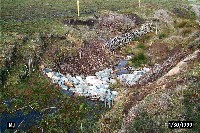 Click on image to enlarge (46K). Click here to display a larger version (277K).
Click on image to enlarge (46K). Click here to display a larger version (277K).This photo shows a marshy tributary of Stemple Creek that is being treated to reduce erosion. The rock has been placed here to repair head cutting. On the far bank adjacent to the rock work a brush mattress and willow waddle have also been constructed to stabilize the banks. Trees should sprout from structures, further increasing the soil catching and filter capacity of the riparian here. Note that live stock has also been excluded from this sensitive habitat. Photo provided courtesy of Marin Resource Conservation District and taken on January 30, 1999.
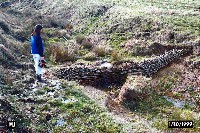 Click on image to enlarge (52K). Click here to display a larger version (288K).
Click on image to enlarge (52K). Click here to display a larger version (288K).This photo shows a headcut repair using a willow waddle. The bundle of willow sticks will block sediment transport and head cutting and will sprout, increasing the sediment trapping capability of the structure and increasing the filtering capacity of this part of the Stemple Creek riparian zone. Photo taken on January 30, 1999 and provided courtesy of Marin Resource Conservation District.
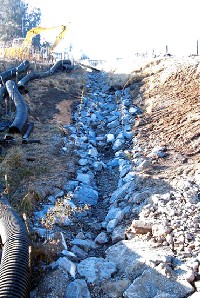 Click on image to enlarge (122K).
Click on image to enlarge (122K).This photo shows a gully being lined with rip rap to prevent further bank erosion and head cutting. Photo provided courtesy of Marin Resource Conservation District.
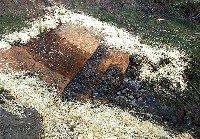 Click on image to enlarge (49K). Click here to display a larger version (273K).
Click on image to enlarge (49K). Click here to display a larger version (273K).Jute netting fabric reinforced with rock fill are used to repair a head cut. Live aquatic plant species have also been used to provide additional filter capacity and soil holding ability once the plants mature. Photo provided courtesy of Marin Resource Conservation District.
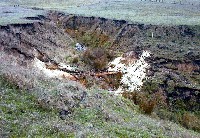 Click on image to enlarge (43K). Click here to display a larger version (259K).
Click on image to enlarge (43K). Click here to display a larger version (259K).This large gully on Stemple Creek has had measures taken to repair it or to at least retard its growth. Vegetated earthen fill called a coir roll is pinned by live willow stakes perpendicular across the gully. Plugs of the wetland adapted Juncus have also been planted to help trap sediment and stabilize soil with their roots. Photo provided courtesy of Marin Resource Conservation District.
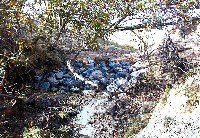 Click on image to enlarge (60K). Click here to display a larger version (327K).
Click on image to enlarge (60K). Click here to display a larger version (327K).This photo shows use of rocks to prevent further head cutting. It also appears that jute netting is being used to trap sediment above the rock work. Photo provided courtesy of Marin Resource Conservation District.
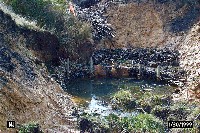 Click on image to enlarge (49K). Click here to display a larger version (270K).
Click on image to enlarge (49K). Click here to display a larger version (270K).This photo shows a willow waddle which has been installed to repair head cutting in this very large gully in the Stemple Creek watershed. Photo taken on January 30, 1999 and provided courtesy of Marin Resource Conservation District.
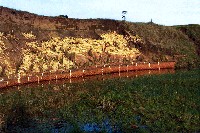 Click on image to enlarge (36K). Click here to display a larger version (219K).
Click on image to enlarge (36K). Click here to display a larger version (219K).This photo shows an eroding stream bank lower Stemple Creek and the use of a material called Biology to protect the toe of the feature. Plugs of the wetland species Juncus have also been planted to help stabilize this source of sediment to the creek. Photo provided courtesy of Marin Resource Conservation District.
To learn more about this topic click Info Links
To view additional information (data source, aquisition date etc.) about this page, click Metadata
 Click on image to enlarge (46K). Click here to display a larger version (277K).
Click on image to enlarge (46K). Click here to display a larger version (277K). Click on image to enlarge (52K). Click here to display a larger version (288K).
Click on image to enlarge (52K). Click here to display a larger version (288K). Click on image to enlarge (122K).
Click on image to enlarge (122K). Click on image to enlarge (49K). Click here to display a larger version (273K).
Click on image to enlarge (49K). Click here to display a larger version (273K). Click on image to enlarge (43K). Click here to display a larger version (259K).
Click on image to enlarge (43K). Click here to display a larger version (259K). Click on image to enlarge (60K). Click here to display a larger version (327K).
Click on image to enlarge (60K). Click here to display a larger version (327K). Click on image to enlarge (49K). Click here to display a larger version (270K).
Click on image to enlarge (49K). Click here to display a larger version (270K). Click on image to enlarge (36K). Click here to display a larger version (219K).
Click on image to enlarge (36K). Click here to display a larger version (219K).